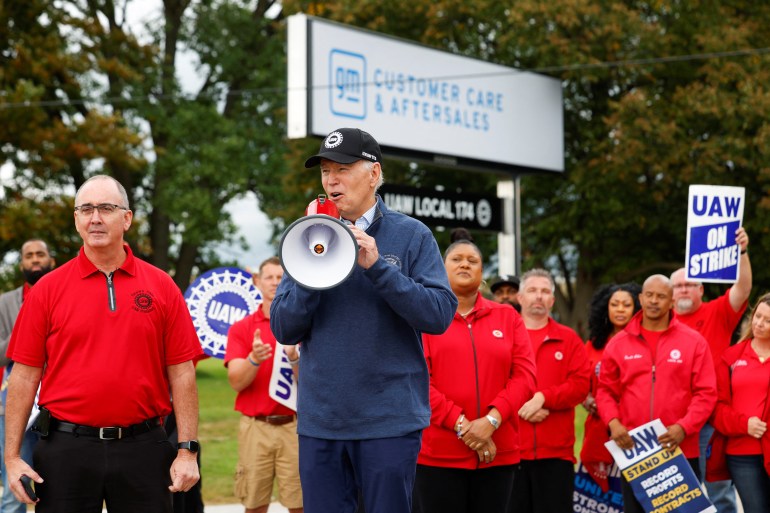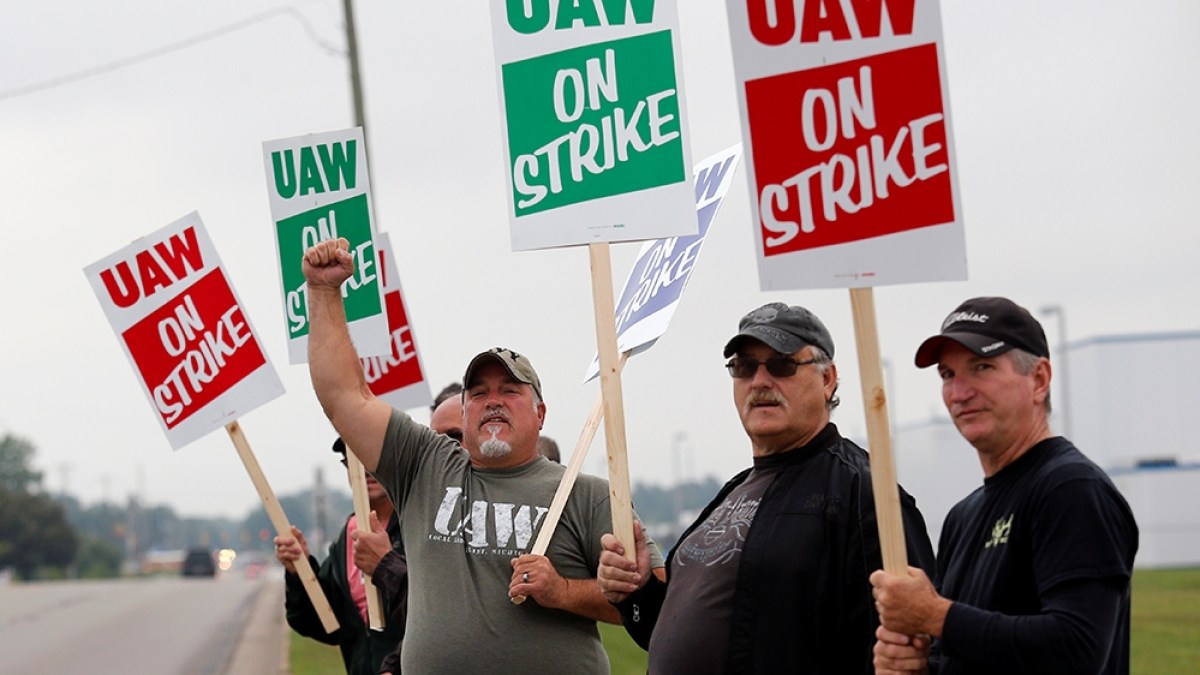Towards the end of 1936, autoworkers in Flint, Michigan marched into the nerve centre of General Motors and sparked a match that lit a collective organising flame.
Their occupation of key Chevrolet and Buick factories during the Great Depression came to be known as the “sit down strike” for the way the workers put their bodies on the line, physically occupying buildings inside and neutralising the vulnerabilities of a picket line.
After a tense few months, the striking autoworkers emerged victorious, with higher wages, and a newly powerful United Auto Workers union, inspiring a wave of other strikes across the country.
More than eight decades later, US autoworkers are seeking to trigger a similar movement, with a rebranded “stand up strike” that has captured the nation’s imagination at a time of growing support for unions and mobilisation of workers.
“This is a strike that starts small and builds over time, as more and more of us stand up to join the fight,” said UAW President Shawn Fain, as the union launched targeted and simultaneous strikes on September 15 on the big three Detroit automakers: Ford, General Motors and Stellantis, which owns Jeep and Chrysler.
So far, nearly 20,000 autoworkers across 20 states have been called to strike, with a new set of walkouts announced today.
Days after the autoworkers took to the picket lines, the five-month Hollywood writers strike came to an end with a new contract, bookending the “hot labour summer” that has rippled across North America. From nurses to grocery store clerks, from postal workers to screenplay writers, and railway employees, more workers in the United States and Canada have been walking off the job or threatening to do so, with solidarity also being expressed from Mexico.
“They’re sort of feeding off each other,” said Barry Eidlin, a sociology professor at Montreal’s McGill University who studies labour movements.
“We haven’t seen this many high-profile strikes happening all at once in a while,” agreed Hayley Brown, a research associate at the Washington, DC-based think tank Center for Economic and Policy Research. “There are definitely things that suggest that this is new,” she noted, but “it remains to be seen how much of a watershed moment it will be.”
What is happening with the labour movement?
Increasing strike action is typically a sign of union power. According to the National Labor Relations Board, union representation was up 14 percent in the United States in the first six months of fiscal year 2023, compared with the same period last year. A recent Gallup poll also put union approval at 67 percent in the country this year, making it the fifth straight year it exceeded its long-term average.
But these positive indicators belie the fact that union membership is at an all-time low – just 10 percent of the share of employees in the US, and 6 percent when considering only the private sector.
“If I have to put my finger on it, there’s much more of an independent worker-led organising character to what is going on,” said Eidlin. He pointed to the recent unionising at Starbucks and Amazon as proof of grassroots campaigning, along with the emergence of rank-and-file reform movements within the UAW and the UPS Teamsters that have pushed for a more confrontational approach.
What brought us here?
Eidlin saw a confluence of factors leading to this point, starting with at least 40 years of eroding work quality, stagnating pay and growing inequality. Autoworker wages, for instance, have declined by 30 percent in the last 20 years when factoring in inflation, while CEO pay has increased by 40 percent in the last four years.
That apart, employment is less stable. People have to work more hours. Gig work has become normal, and pensions are fraying.
Layer on top of that the pandemic, which helped crystallise these pressure points, and in some cases – such as grocery workers who were hailed as heroes and essential, only to see their pandemic pay pulled – added insult to injury.
“I think that having a tighter labour market makes people more ambitious in terms of what they can fight for,” added Brown. The harder workers are to replace, the more comfortable they have become demanding better working conditions.
“It gave some structural leverage to workers in terms of their bargaining power,” said Eidlin.
The result is not just walking off the job, but workers voting down contracts. “That’s definitely a big thing here in Canada,” said Eidlin. Workers at Metro, a major grocery store chain, rejected a contract in July, as did salt mine workers in Windsor, Ontario.
“The contracts are not getting rejected because they are bad, but because they are not good enough,” said Eidlin. Even the recently ratified Ford autoworkers contract in Canada, which he said “was rightly viewed as one of the richest contracts” Unifor, the union, negotiated, received just 54 percent approval.
Why are auto workers so significant?

Autoworkers embody the image of a union worker in the US. And they have historically, in particular with the United Auto Workers union, been at the forefront of labour gains.
That diluted over the decades, culminating in a scandal that began to unravel in 2015, exposing gross levels of corruption in the UAW leadership, with union brass taking bribes, stealing union money and getting kickbacks in exchange for contract concessions. Fifteen members of UAW leadership were convicted on fraud and corruption charges, and went to prison, including two former presidents.
In 2020, the UAW agreed to a referendum that changed the way the top leadership was elected, from a convention that had stifled the ability of workers to have their voices heard, to a direct system of voting.
This opened the pathway for a harder-line group of union worker reformers in the US, known as the United All Workers for Democracy that had been organising on the sidelines to win seats in the executive – including the presidency, with Shawn Fain.
“You wouldn’t have had this strike that you’re seeing right now” without them, said Eidlin.
The result is a different kind of strike strategy. The union is using the element of surprise with targeted walkouts at certain plants giving themselves room to escalate, and also preserving their strike fund, so they can negotiate for longer, said Brown.
“It is a strike that has the potential to put the UAW back in the driver’s seat for the entire labour movement,” said Eidlin.
What are the political ramifications?
There are many, as was made clear by the duelling visits to autoworker ground zero by the most politically powerful men in the United States this week.
Wearing a UAW ballcap and flanked by union bosses, President Joe Biden visited the picket line in Wayne County, Michigan on Tuesday, the first sitting president to do so “in modern times”, according to the White House.
“Stick with it because you deserve the significant raise that you need and other benefits,” said President Biden, speaking through a bullhorn, as he noted the “sacrifices” that workers made in 2008, when the car companies were in trouble, and needed a $17.4bn government bailout. “Let’s get back what we lost.”

Donald Trump, who amid legal scandals is still vying for a return to office in 2024, held a rally in a non-union factory in Michigan on Wednesday to court the working-class vote that helped propel him to the presidency in 2016.
Trump has taken a combative approach with the unions, seeking to sow divisions between leadership and the rank and file by urging workers not to pay union dues, and claiming the union brass have “deals” going on.
Under Biden, the National Labor Relations Board has been “more actively fulfilling its role” on behalf of workers, with new appointees who are reforming rules so that it is easier for workers to unionise, Brown said.
But the Biden administration also intervened in a labour dispute involving railway workers last year, imposing a contract that averted a strike, and did not meet worker demands, such as paid sick leave.
What is the economic fallout?
According to economists, it has been significant. One analysis published by the Anderson Economic Group, a Michigan-based organisation that follows labour strikes, pegged the total economic losses in the first week from the UAW strike at more than $1.6bn.
The car industry represents 3 percent to 3.5 percent of the US gross domestic product, raising questions about wider economic spillover effects. Striking workers have also been cast by some observers as an impediment to environmental progress, noting that the strike might affect the rollout of electric vehicles, even though the UAW has repeatedly said it supports the green transition.
In an editorial run in the Detroit Free Press last week, Mark Reuss, the president of GM, took aim at the “misinformation” he said was emanating from the union, and defended what he called an “historic” offer on the table that included a 20 percent wage rise across four years, that he said would ensure that 85 percent of current represented employees would earn a base wage of about $82,000 a year.
He called the union’s demands “untenable” and dismissed claims that “record profits go toward fuelling corporate greed” as “a myth.” The union is seeking a 36 percent wage rise over four years.
But both Brown and Eidlin say autoworkers are actually trying to dig themselves out of a financial hole that has been growing for years.
“The economic cost of not striking is we have this economy that has not worked for most workers for the last 50 years,” said Eidlin. “What we have here is an effort to fix that damage.”
